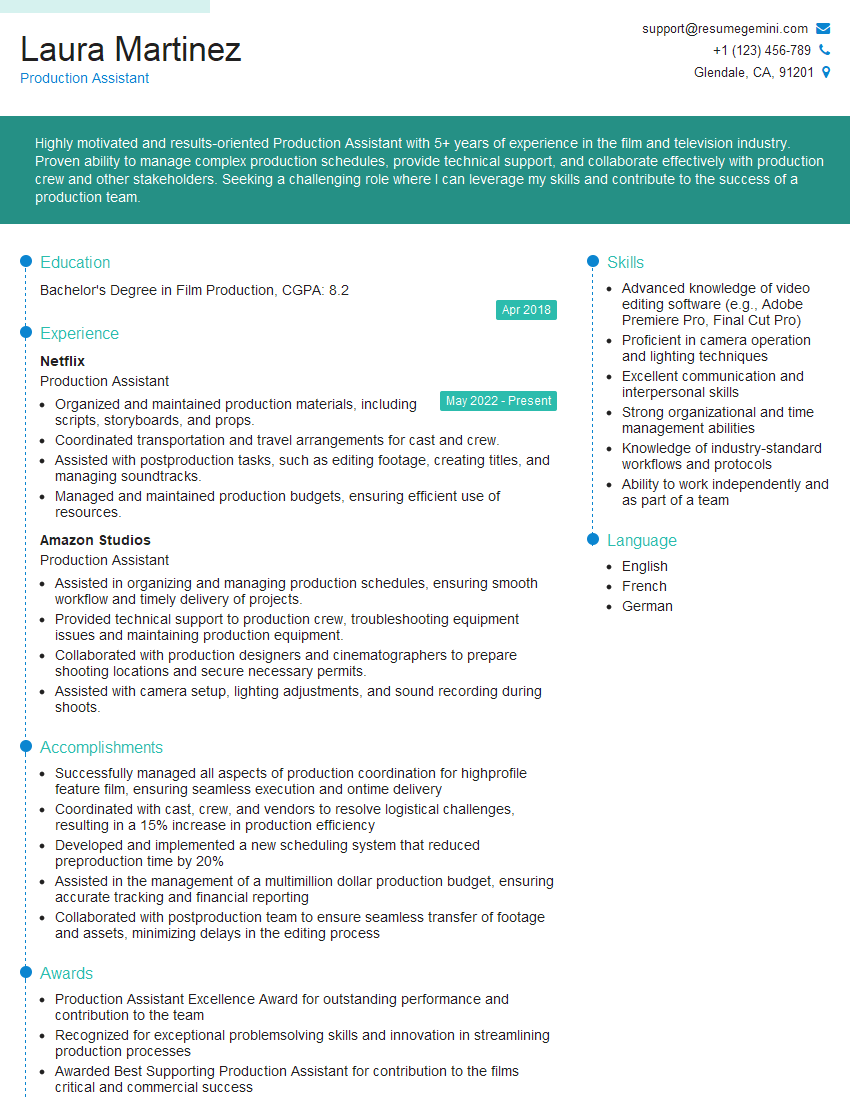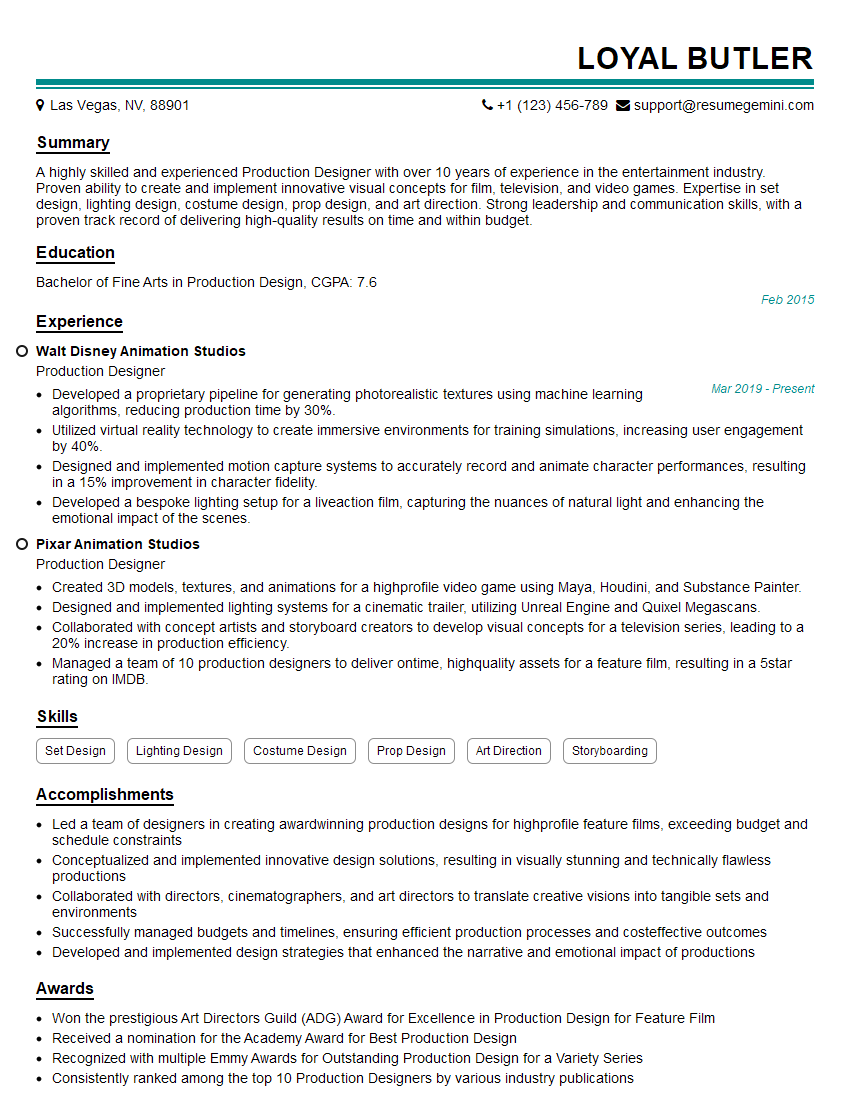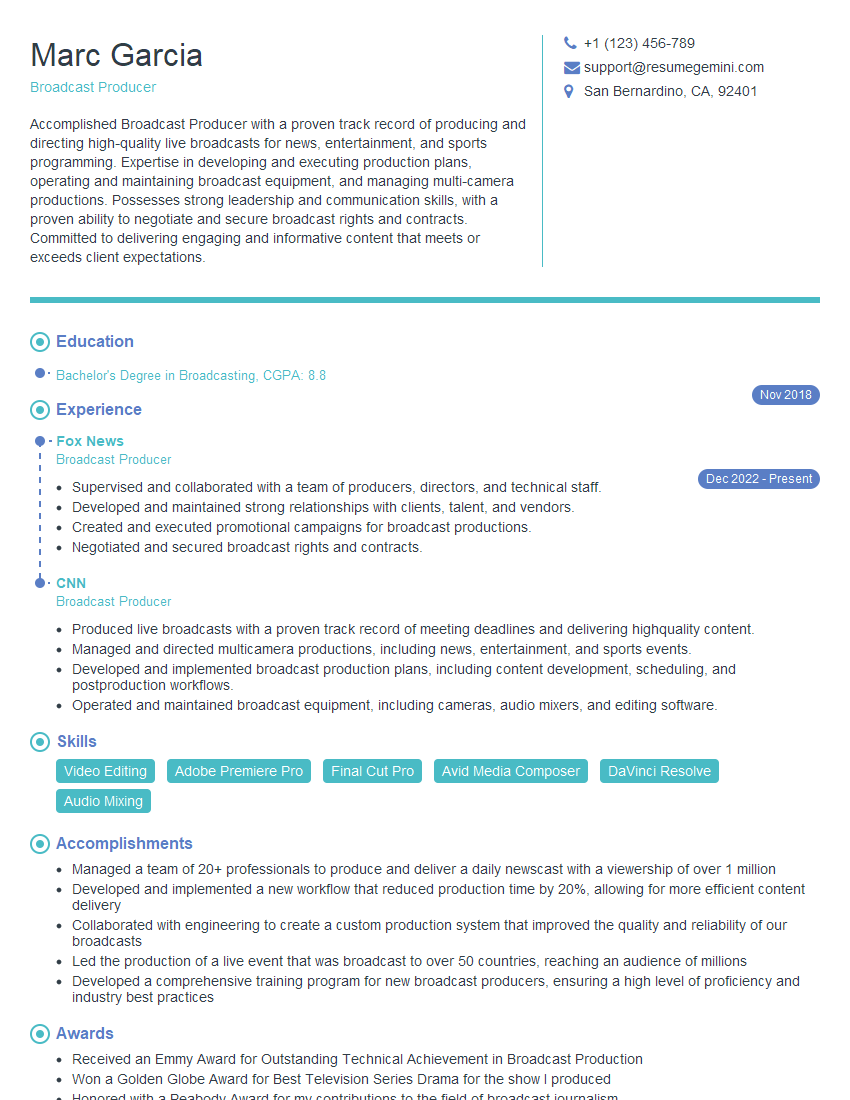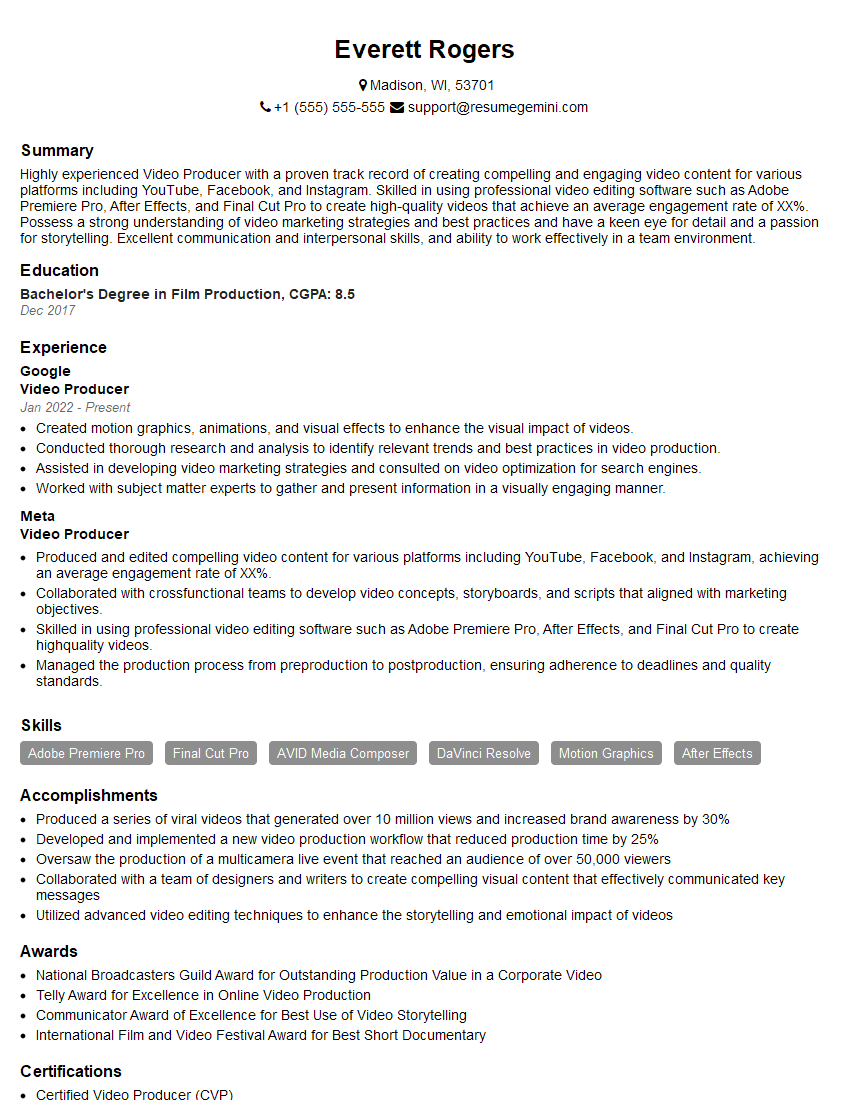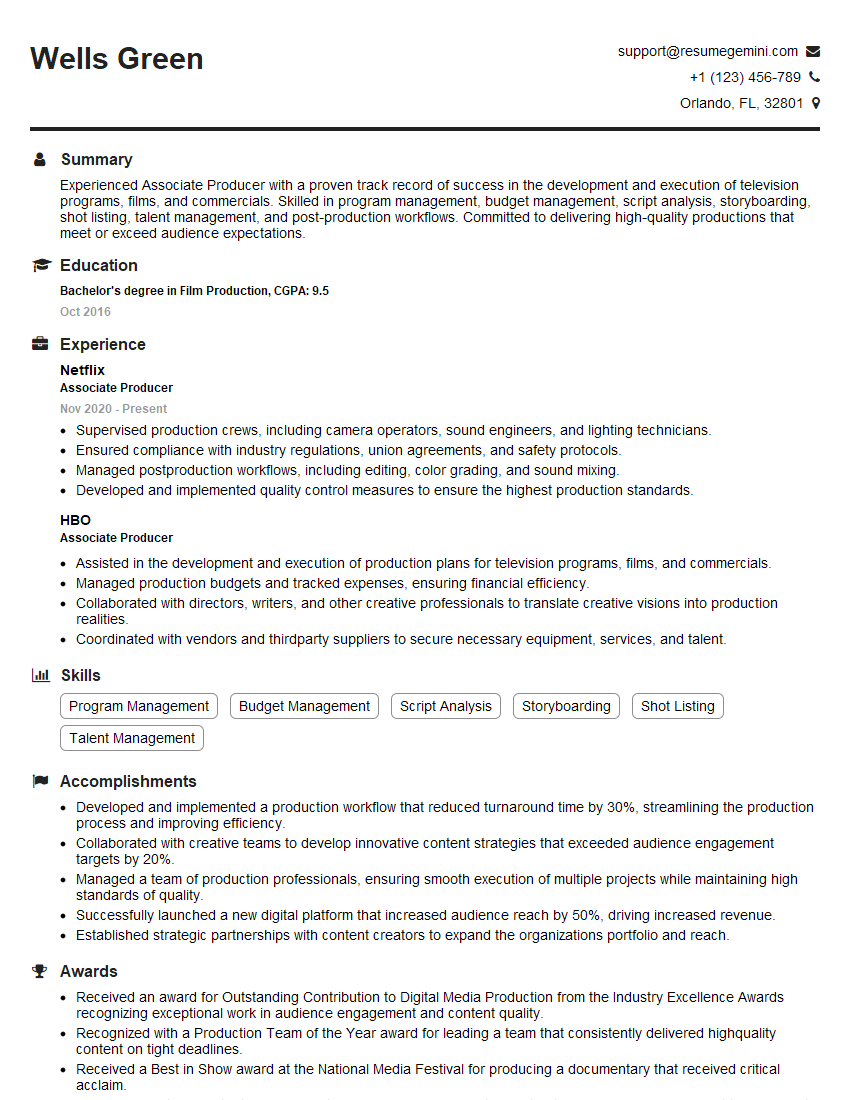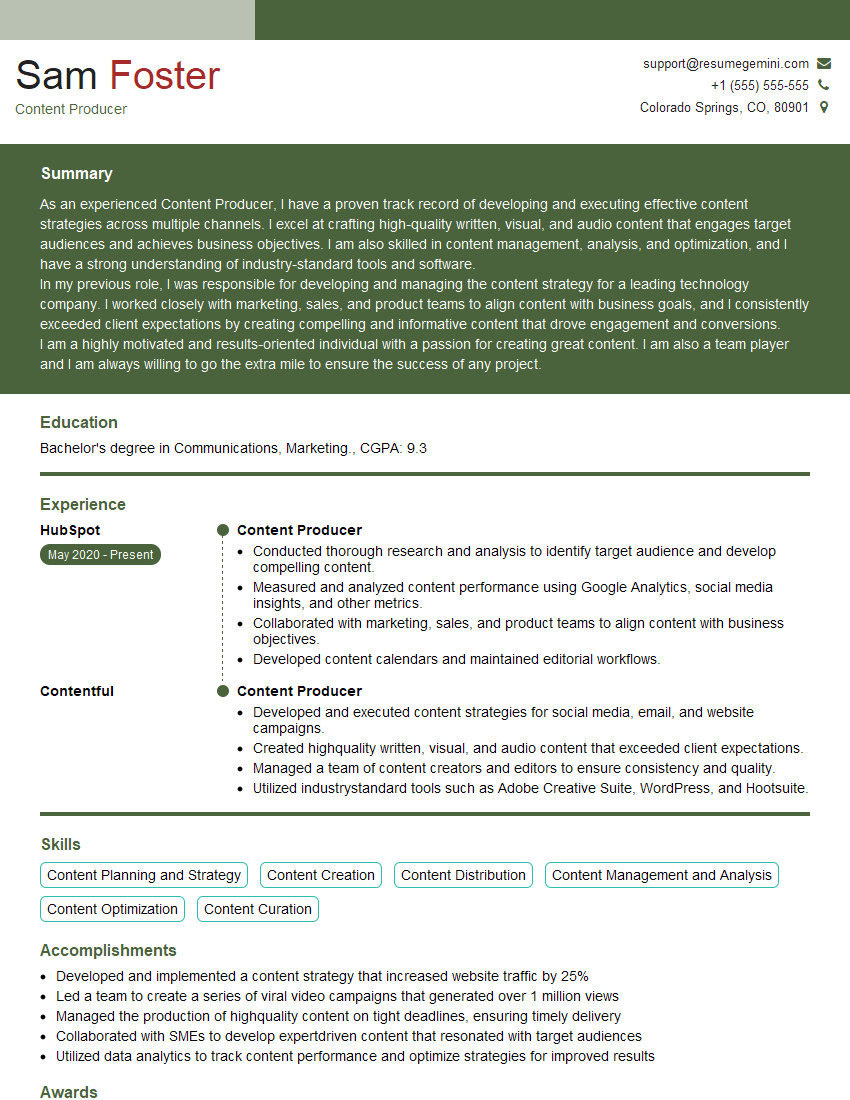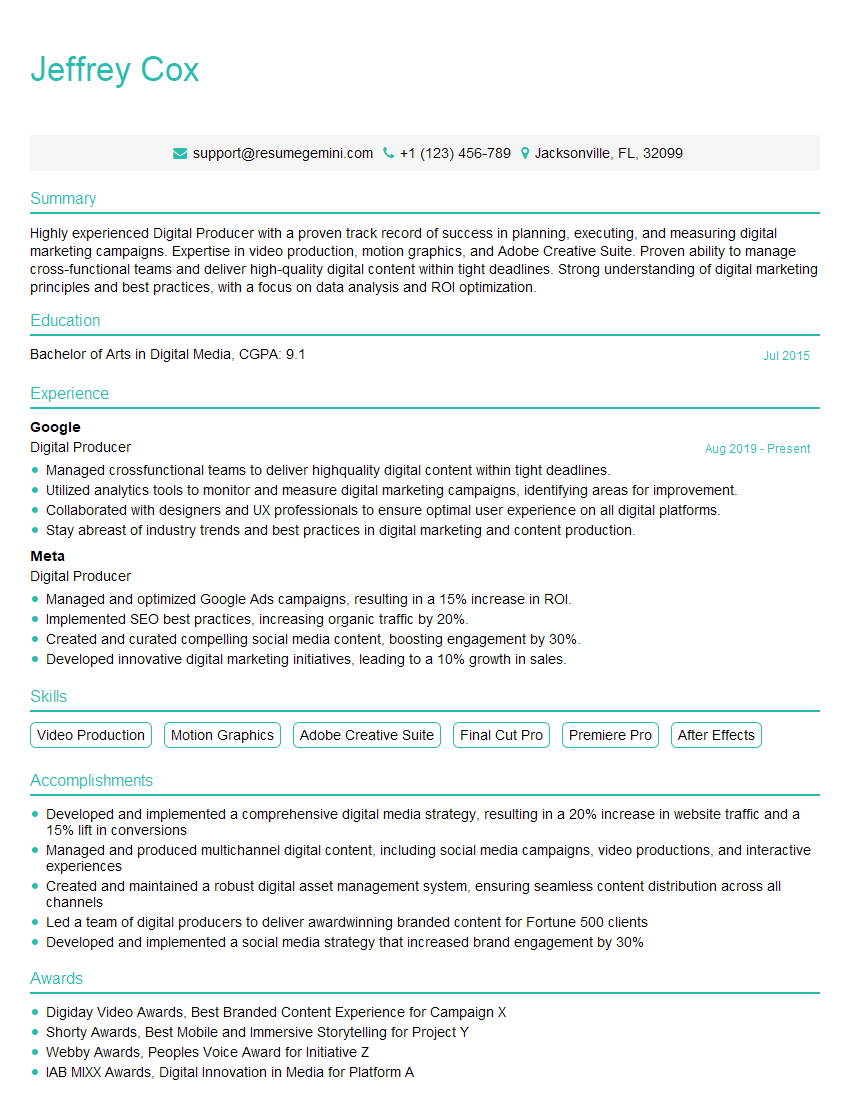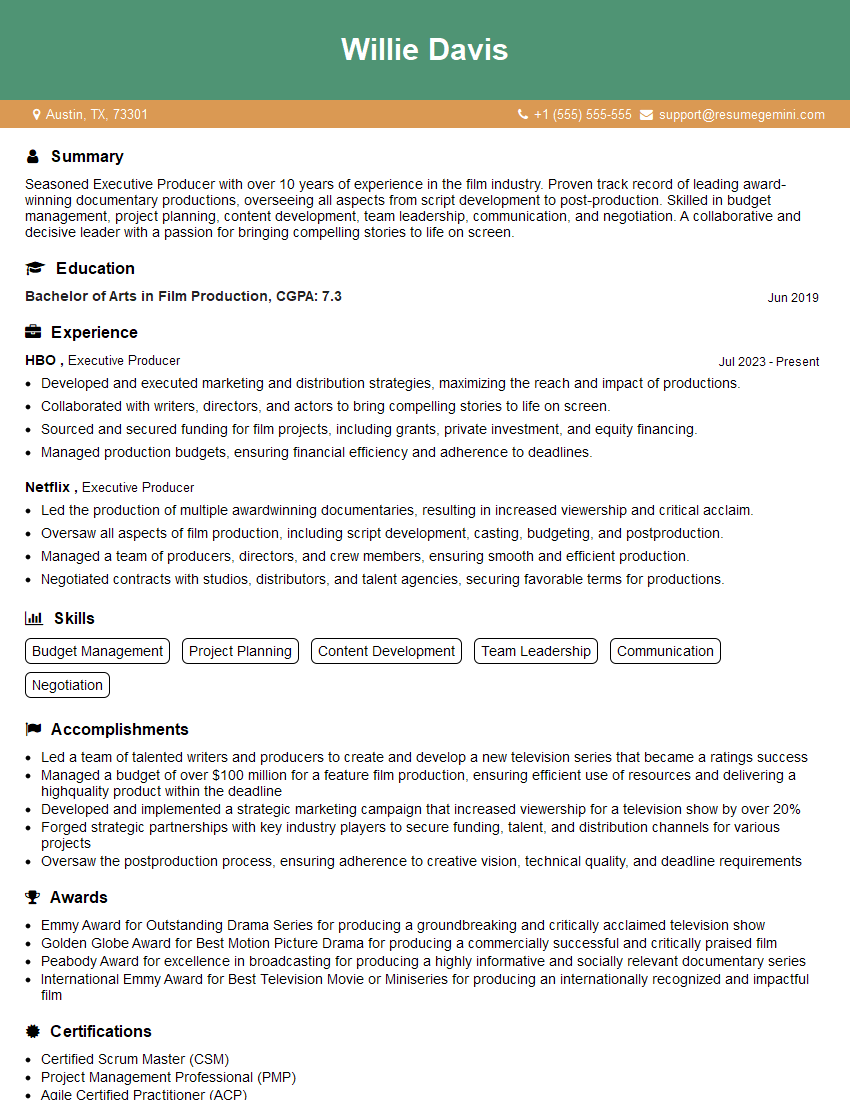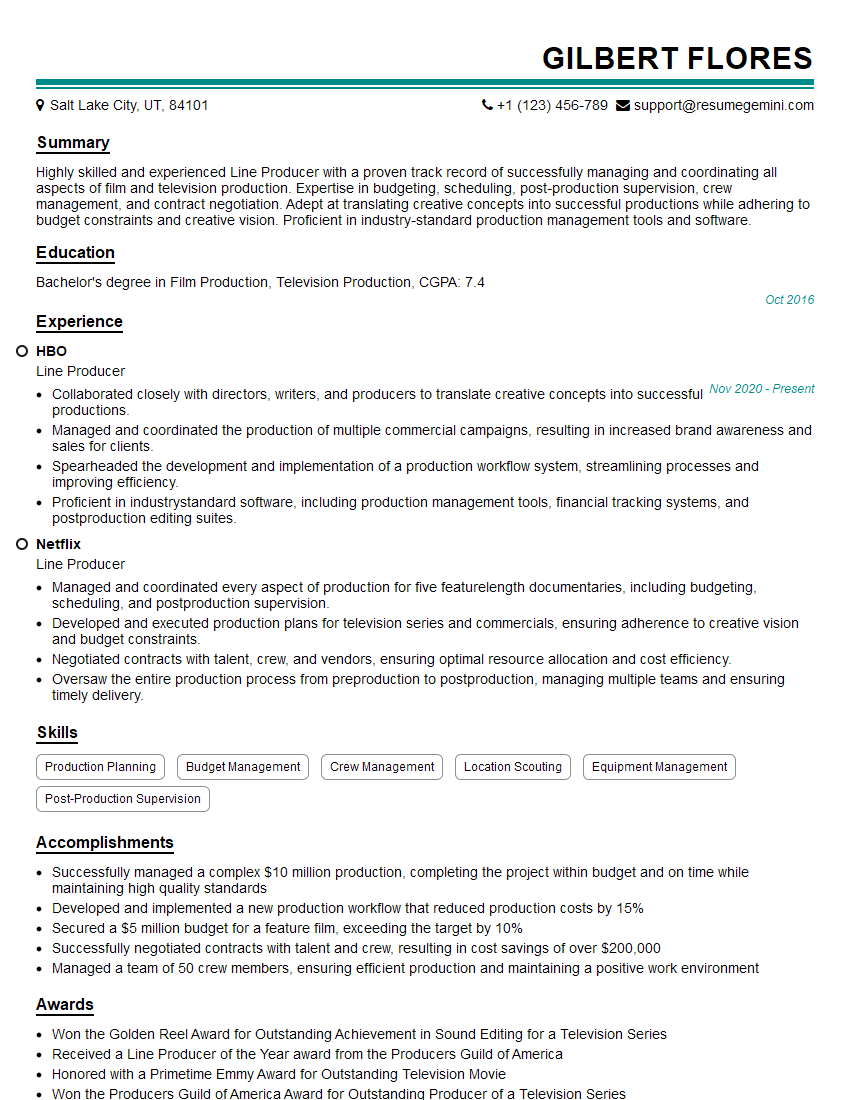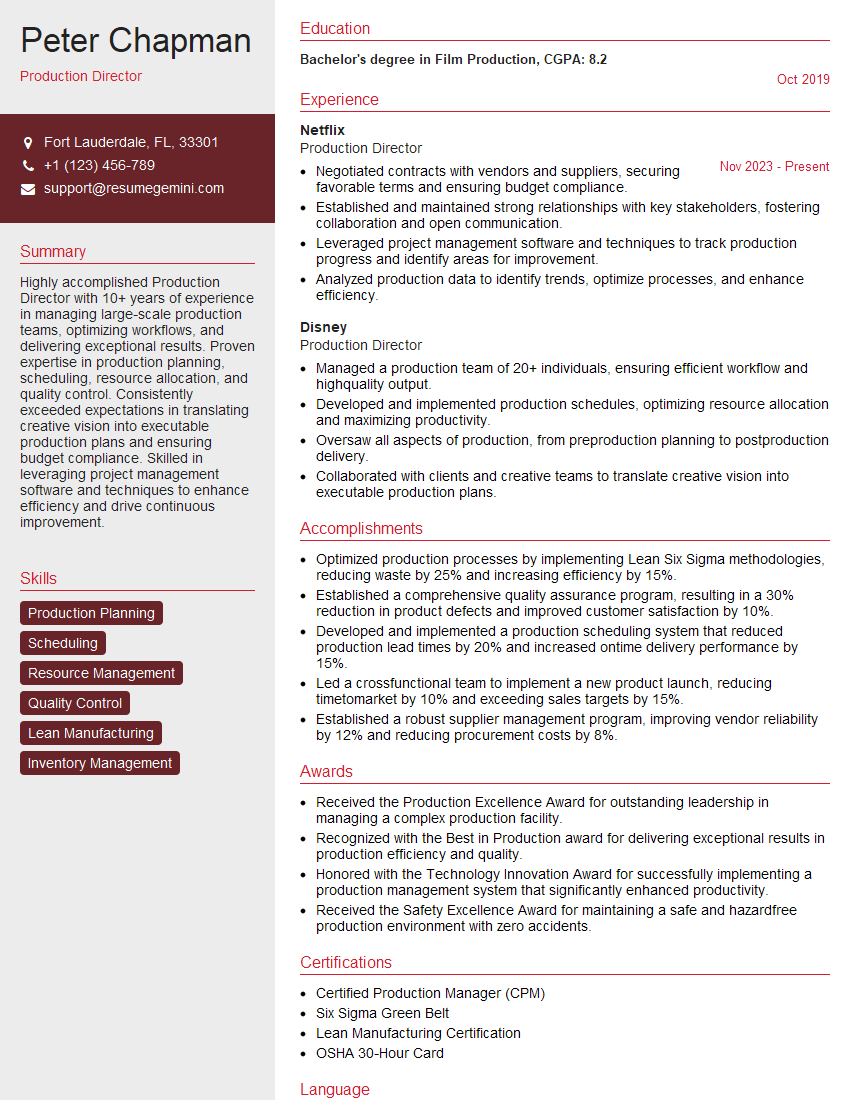The thought of an interview can be nerve-wracking, but the right preparation can make all the difference. Explore this comprehensive guide to Collaborating with Production Teams interview questions and gain the confidence you need to showcase your abilities and secure the role.
Questions Asked in Collaborating with Production Teams Interview
Q 1. Describe your experience managing production schedules.
Managing production schedules effectively involves a blend of meticulous planning, proactive monitoring, and agile adaptation. I begin by creating a comprehensive schedule using project management software, breaking down large projects into smaller, manageable tasks with clearly defined deadlines and assigned responsibilities. This involves considering resource allocation (personnel, equipment, materials), potential bottlenecks, and dependencies between tasks.
For example, in a recent film production, I utilized a Gantt chart to visualize the interconnectedness of filming, editing, sound design, and visual effects. This allowed me to identify potential delays early on, such as the need for specific locations to be available for shooting at the same time. I then proactively addressed these potential issues by securing the necessary resources in advance.
Regular monitoring is crucial; I use daily stand-up meetings and progress reports to track actual progress against the planned schedule. Any deviations are immediately addressed through collaboration with team members to find solutions, adjusting the schedule as needed. This proactive approach minimizes the impact of unforeseen challenges.
Q 2. How do you handle conflicting priorities within a production team?
Conflicting priorities are inevitable in a production environment. My approach prioritizes clear communication and a collaborative prioritization process. First, I gather all stakeholders and thoroughly document each competing priority, including its urgency, importance, and impact on the overall project goals. This transparency helps everyone understand the bigger picture. Then, using a weighted scoring system or a prioritized task list (potentially utilizing a Kanban board), we objectively assess and rank the priorities.
For instance, if we faced a situation where a critical scene needed to be filmed urgently, but it required a set redesign, I would convene a meeting to determine the best path forward. Would delaying a less critical scene allow enough time for the redesign? Could the critical scene be adapted slightly to work with the existing set? This collaborative approach ensures buy-in from all stakeholders, minimizing resentment and enhancing team cohesion. The key is to always be transparent and to communicate the reasoning behind the decision.
Q 3. Explain your approach to conflict resolution in a production environment.
My approach to conflict resolution is rooted in proactive communication and collaborative problem-solving. I believe that most conflicts stem from misunderstandings or unmet needs. Therefore, I encourage open dialogue. When a conflict arises, I facilitate a meeting where all involved parties can express their concerns and perspectives in a safe and respectful environment. I act as a neutral mediator, focusing on understanding the root cause of the conflict rather than assigning blame.
For example, if two team members disagreed about the best approach to a particular effect, I would encourage them to present their respective arguments and collaboratively explore solutions. I might suggest brainstorming alternative approaches together or conducting a small test to compare the different methods. The goal is to arrive at a mutually agreeable solution that addresses everyone’s needs and concerns while maintaining the overall project goals.
Q 4. How do you ensure effective communication across different production departments?
Effective cross-departmental communication is essential for a smoothly running production. I leverage several strategies to facilitate this, including: regular cross-functional meetings, a centralized communication hub (like a shared project management platform or an intranet), and clearly defined communication protocols.
For instance, I schedule weekly meetings involving representatives from all relevant departments (e.g., filming, editing, post-production) to discuss progress, challenges, and potential dependencies. I also establish a centralized platform where all relevant documents, schedules, and communication threads are stored and accessible to everyone. Finally, I establish clear communication protocols – such as outlining reporting structures, frequency of updates, and preferred communication methods – to avoid confusion and ensure information flows efficiently.
Q 5. Describe a time you had to adapt to unexpected changes in a production schedule.
During a live event production, a major storm caused a power outage, halting the broadcast. Our original schedule relied heavily on external power sources. The immediate challenge was to quickly transition to a backup plan with minimal disruption. I quickly assembled the team and we identified our available backup generators. This involved coordinating communication across lighting, sound, and camera teams.
We revised the schedule on the fly, prioritizing essential segments and adjusting the running order. We opted to temporarily reduce the visual aspects to conserve energy. Through this rapid adaptation and the team’s collaborative efforts, we managed to resume the broadcast with only a minor delay. This experience highlighted the importance of having contingency plans and fostering a flexible and responsive team.
Q 6. How do you utilize project management tools to enhance team collaboration?
Project management tools are invaluable for enhancing team collaboration. I utilize tools such as Asana, Trello, or Monday.com to centralize tasks, track progress, and facilitate communication. These platforms allow for real-time updates, task assignments, file sharing, and progress visualization through Gantt charts, Kanban boards, and other helpful visualizations.
For example, in a recent project, using Asana allowed us to easily assign tasks, track deadlines, and identify bottlenecks. The platform’s notification system ensured that team members were always aware of updates and changes. The ability to attach files directly to tasks eliminated confusion about version control and ensured everyone was working from the latest iteration. This centralized approach fostered transparency, accountability, and enhanced overall team collaboration.
Q 7. What strategies do you employ to maintain team morale during high-pressure production periods?
Maintaining team morale during high-pressure periods is crucial for productivity and overall project success. I prioritize open communication, regular recognition of achievements, and opportunities for team bonding. Open communication helps address concerns and build trust; recognizing individual and team accomplishments boosts morale and reinforces positive contributions; and fostering a sense of camaraderie through team-building activities creates a supportive and motivating environment.
In a recent project with tight deadlines, I implemented short, daily “wins” meetings where we acknowledged each team member’s accomplishments. We also celebrated milestones with small treats or informal gatherings. We utilized a team communication channel for non-work related sharing as well to help build personal connections. By prioritizing team well-being, I found that the team was more resilient, engaged, and ultimately more productive under pressure.
Q 8. How do you measure the success of a production project from a collaboration perspective?
Measuring the success of a production project from a collaboration perspective goes beyond simply meeting deadlines and budget. It’s about assessing the effectiveness of teamwork and communication throughout the entire process. I use a multi-faceted approach, focusing on three key areas:
- Team Efficiency: This involves tracking metrics like task completion rates, cycle times (the time it takes to complete a task), and the number of revisions needed. A high completion rate and short cycle times with minimal revisions indicate effective collaboration and efficient workflows. For instance, if we consistently meet sprint goals and require minimal rework, it signals strong team collaboration.
- Communication Effectiveness: I monitor the frequency and quality of communication. This can include analyzing the number of meetings, the responsiveness to queries, and the clarity of communication within project management tools. For example, we track the response time to requests in our project management software. A quick response time suggests efficient and effective communication.
- Team Morale and Satisfaction: I regularly conduct informal check-ins and utilize anonymous surveys to gauge team morale and satisfaction. High levels of satisfaction suggest a collaborative and positive work environment conducive to productivity. We often include a quick question at the end of our daily stand-up meetings to assess morale and identify areas for improvement.
By tracking these metrics and gathering qualitative feedback, I gain a holistic understanding of the collaborative success of a production project. The ultimate goal isn’t just to deliver a product, but to deliver it effectively and foster a strong, productive team.
Q 9. Explain your experience with remote collaboration tools and techniques.
I have extensive experience with various remote collaboration tools and techniques, adapting my approach based on project needs and team preferences. My toolkit includes:
- Project Management Software: Jira, Asana, Trello – for task assignment, progress tracking, and communication.
- Video Conferencing: Zoom, Google Meet – for regular team meetings, brainstorming sessions, and one-on-one check-ins. I emphasize using video to foster a sense of connection and build rapport.
- Instant Messaging: Slack, Microsoft Teams – for quick questions, updates, and informal communication. We establish clear communication channels for different purposes (e.g., #general, #design, #development).
- Document Collaboration Tools: Google Docs, Microsoft Office 365 – for real-time co-editing of documents, reducing the need for endless email chains.
- Version Control Systems: Git – for managing code collaboratively and tracking changes.
Beyond the tools, effective remote collaboration hinges on establishing clear communication protocols, setting expectations, and fostering a culture of transparency and accountability. Regular check-ins, well-defined roles, and a focus on asynchronous communication (allowing responses outside of real-time interaction) are essential for successful remote teamwork. For example, I’ve found that setting a clear communication schedule helps to prevent information overload and allows team members to prioritize tasks effectively.
Q 10. Describe your process for delegating tasks within a production team.
My process for delegating tasks is built on a foundation of understanding individual strengths, workload, and project priorities. It’s not just about assigning tasks, but about empowering team members.
- Assess Skills and Workload: I carefully review each team member’s skill set and current workload before assigning tasks. This includes considering their experience level, interests, and available time.
- Provide Clear Instructions: When delegating, I provide clear, concise instructions, including the desired outcome, deadlines, relevant resources, and expected quality standards. Ambiguity is the enemy of effective collaboration.
- Establish Communication Channels: I define clear communication channels for each task—whether it’s through project management software, instant messaging, or email—to ensure seamless communication and feedback loops.
- Offer Support and Guidance: I’m always available to provide support and guidance, ensuring team members feel comfortable asking questions and seeking assistance. Micromanagement is detrimental; instead, I focus on offering support when needed.
- Monitor Progress and Provide Feedback: I regularly monitor progress and provide constructive feedback to help team members stay on track and improve their performance. This creates a continuous learning environment.
For example, when assigning a complex design task, I might pair a junior designer with a senior designer to provide mentorship and ensure high quality while fostering skill development.
Q 11. How do you identify and address individual team member skill gaps?
Identifying and addressing skill gaps is crucial for team growth and project success. I use a multi-pronged approach:
- Performance Reviews and Feedback: Regular performance reviews and constructive feedback sessions provide valuable insights into individual strengths and weaknesses.
- Skill Assessments: Using questionnaires, practical exercises, or code reviews allows for a more objective assessment of skill levels.
- Observation and Mentorship: Direct observation of team members during tasks, combined with mentorship from senior team members, can reveal areas for improvement.
- Training and Development: Once skill gaps are identified, I work with team members to create individualized development plans that might include online courses, workshops, or mentorship opportunities.
- Cross-training: Encouraging team members to learn from each other and share their expertise builds a more versatile and resilient team.
For instance, if a team member struggles with a specific software, I might arrange for them to participate in a training course, or pair them with someone who has strong skills in that area.
Q 12. How do you foster a collaborative environment that encourages creative problem-solving?
Fostering a collaborative environment that encourages creative problem-solving requires a conscious effort to cultivate a culture of trust, respect, and open communication. Here’s how I approach it:
- Establish a Safe Space: Creating a psychologically safe environment where team members feel comfortable sharing ideas, even if they are unconventional, is essential. I actively encourage dissenting opinions and different perspectives, emphasizing that constructive criticism is a valuable tool for improvement.
- Brainstorming Sessions: Regular brainstorming sessions, using techniques like mind mapping or lateral thinking, can unlock creative solutions. I ensure everyone has a voice and feels their contributions are valued.
- Cross-functional Collaboration: Encouraging interaction between team members with diverse skill sets can lead to innovative solutions. Bringing together designers, developers, and project managers in problem-solving sessions can generate fresh perspectives.
- Gamification and Challenges: Introducing elements of friendly competition or gamification can boost creativity and engagement. This could involve setting challenges or assigning points for innovative solutions.
- Celebrate Successes: Acknowledging and celebrating both large and small achievements strengthens team morale and motivates further creative endeavors. Public recognition of accomplishments is very effective.
For example, we once used a Lego building exercise to solve a complex design problem, which fostered collaboration and resulted in a surprisingly creative solution.
Q 13. How do you ensure all team members are informed and up-to-date on project progress?
Keeping everyone informed and up-to-date is critical for maintaining project momentum and preventing misunderstandings. My strategies include:
- Regular Team Meetings: Daily stand-up meetings (short, focused updates) and weekly progress meetings (more in-depth discussions) are crucial. These meetings maintain transparency and allow for immediate clarification of any concerns.
- Project Management Software: Utilizing project management tools to track progress, assign tasks, and share documents ensures everyone has access to the latest information. I encourage team members to actively update their tasks and provide progress reports.
- Communication Channels: Establishing clear communication channels (e.g., Slack channels for specific project topics) helps to organize information and reduces the chance of important updates being missed.
- Progress Reports: Regular progress reports, sent to stakeholders and the team, provide a comprehensive overview of the project’s status and any potential roadblocks.
- Visual Progress Tracking: Using dashboards and visual representations (e.g., Gantt charts) allows for a quick and easily understandable overview of project progress.
Transparency and proactive communication are key. I believe in over-communicating rather than under-communicating, ensuring everyone is aware of changes and potential challenges.
Q 14. Describe a time you had to mediate a disagreement between team members.
In a previous project, a disagreement arose between a designer and a developer regarding the feasibility of a design element. The designer felt their vision was essential to the project’s aesthetic appeal, while the developer argued it would be excessively complex and time-consuming to implement. The tension was escalating and impacting team morale.
My approach was to facilitate a constructive discussion, acting as a neutral mediator. I followed these steps:
- Active Listening: I started by allowing each party to fully explain their perspective without interruption. This helped them feel heard and understood.
- Identify the Root Cause: I helped them identify the root cause of the conflict—miscommunication about the technical challenges involved in implementing the design element.
- Find Common Ground: I guided them towards finding common ground—both parties agreed the project’s overall success was paramount.
- Brainstorm Solutions: Together, we brainstormed alternative solutions that preserved the essence of the design while addressing the developer’s concerns about feasibility. This included exploring alternative technologies and adjusting the design slightly.
- Document Agreement: Once a mutually acceptable solution was reached, I documented the agreement and ensured both parties understood and committed to the revised plan.
The result was a compromise that satisfied both parties, preserved the overall project aesthetic, and avoided a major delay. This situation highlighted the importance of active listening, understanding perspectives, and collaboratively finding solutions. It reinforced the value of my role as a facilitator in resolving conflicts and maintaining a positive team dynamic.
Q 15. How do you balance individual contributions with the overall team goals?
Balancing individual contributions with team goals is crucial for successful production. It’s about aligning personal ambitions with the overarching project objectives. I achieve this through a combination of clear communication, proactive collaboration, and a shared understanding of priorities.
- Transparent Goal Setting: I ensure everyone understands the project’s goals and how their individual tasks contribute to the bigger picture. Regular team meetings and progress updates keep everyone aligned.
- Prioritization & Task Management: We utilize project management tools (like Jira or Asana) to prioritize tasks based on their impact on the overall project. This ensures that critical tasks are addressed first, even if it means temporarily postponing less crucial individual contributions.
- Open Communication & Feedback: I foster an environment where team members feel comfortable voicing concerns or suggesting alternative approaches. Regular check-ins allow me to address any potential roadblocks or misalignments early on.
- Example: In a recent project, a team member was deeply invested in optimizing a specific module. While valuable, it risked delaying the overall product launch. Through open communication, we established that the optimization could be a post-launch improvement, allowing us to focus on the core features for the initial release.
Career Expert Tips:
- Ace those interviews! Prepare effectively by reviewing the Top 50 Most Common Interview Questions on ResumeGemini.
- Navigate your job search with confidence! Explore a wide range of Career Tips on ResumeGemini. Learn about common challenges and recommendations to overcome them.
- Craft the perfect resume! Master the Art of Resume Writing with ResumeGemini’s guide. Showcase your unique qualifications and achievements effectively.
- Don’t miss out on holiday savings! Build your dream resume with ResumeGemini’s ATS optimized templates.
Q 16. What methods do you use to track production costs and resources?
Tracking production costs and resources requires a systematic approach. I typically employ a combination of budgeting tools, time tracking software, and regular reporting.
- Budgeting & Forecasting: We create detailed budgets at the project outset, outlining anticipated costs for labor, materials, software licenses, and other expenses. We regularly monitor actual spending against the budget to identify potential overruns.
- Time Tracking: Team members utilize time tracking software (e.g., Toggl, Clockify) to record the time spent on different tasks. This data allows us to analyze resource allocation, identify potential bottlenecks, and improve future estimations.
- Resource Management: We maintain an inventory of resources, including hardware, software, and personnel. This helps to ensure efficient allocation and avoid resource conflicts. Regular reporting provides visibility into resource utilization and identifies areas for optimization.
- Reporting & Analysis: We generate regular reports on costs and resource usage. These reports are analyzed to identify trends, areas for improvement, and potential cost-saving measures. This allows us to make data-driven decisions about resource allocation and project management.
Q 17. How do you onboard new team members to a production project?
Onboarding new team members is a critical process that ensures they are quickly integrated into the project and can contribute effectively. I use a structured approach that combines training, mentorship, and practical experience.
- Pre-boarding: Before the first day, I send the new team member relevant project documentation, including project goals, team structure, and communication protocols.
- Initial Training: We provide comprehensive training on project-specific tools, technologies, and processes. This often includes hands-on training and shadowing opportunities.
- Mentorship: I assign a mentor to the new team member to provide guidance and support throughout the onboarding process. The mentor can answer questions, offer advice, and help the new team member integrate into the team.
- Phased Integration: We gradually increase the new team member’s responsibility, starting with simpler tasks and gradually introducing more complex ones. This allows them to gain confidence and experience.
- Regular Check-ins: I conduct regular one-on-one meetings with the new team member to provide feedback, answer questions, and address any concerns.
Q 18. How do you proactively identify and mitigate potential production risks?
Proactive risk management is essential for successful production. I employ a combination of risk identification techniques, mitigation strategies, and contingency planning.
- Risk Identification: We regularly conduct risk assessments, identifying potential problems that could impact the project’s timeline, budget, or quality. Brainstorming sessions and checklists are useful tools.
- Risk Analysis: We analyze the likelihood and impact of each identified risk. This helps us prioritize mitigation efforts and focus on the most significant threats.
- Mitigation Strategies: We develop specific strategies to mitigate each identified risk. These strategies might involve adding buffer time, securing additional resources, or implementing process improvements.
- Contingency Planning: We develop contingency plans for unforeseen events or risks that cannot be completely mitigated. This ensures that we have a plan in place if things go wrong.
- Example: In a previous project, we identified the risk of a key supplier delaying delivery of critical components. We mitigated this risk by securing an alternative supplier and building a buffer into our schedule.
Q 19. What is your experience with different project management methodologies (Agile, Waterfall, etc.)?
I have extensive experience with both Agile and Waterfall methodologies, and I adapt my approach based on the specific project requirements.
- Waterfall: Suitable for projects with clearly defined requirements and minimal expected changes. It’s a structured approach with sequential phases. I find it useful when dealing with projects that need high predictability and control.
- Agile (Scrum, Kanban): Preferred for projects with evolving requirements or those requiring iterative development. Agile allows for flexibility, adaptation, and rapid feedback loops. My experience with Scrum includes sprint planning, daily stand-ups, sprint reviews, and retrospectives.
- Hybrid Approaches: In some cases, a hybrid approach combining elements of both Waterfall and Agile can be most effective. This might involve using a Waterfall structure for initial planning and an Agile approach for subsequent development iterations.
- Example: For a recent large-scale software project, we used a hybrid approach. The initial phases, involving architecture design and core infrastructure setup, followed a Waterfall approach due to their high complexity and interdependencies. The subsequent development phases adopted an Agile methodology, allowing us to incorporate feedback and adapt to changing needs.
Q 20. Describe your process for providing constructive feedback to team members.
Providing constructive feedback is crucial for team growth and project success. I follow a structured approach to ensure that feedback is helpful, actionable, and well-received.
- Focus on Behavior, Not Personality: I frame feedback around specific behaviors and actions, rather than making generalizations about the individual’s personality.
- Use the SBI Model (Situation-Behavior-Impact): I describe the situation, the specific behavior observed, and the impact of that behavior on the project or team. For example: “In yesterday’s meeting (Situation), your interruption prevented us from completing the agenda item (Behavior), leading to a delay in making a key decision (Impact).”
- Balance Positive and Negative Feedback: I always begin with positive feedback, acknowledging strengths and contributions before addressing areas for improvement. This helps to build trust and maintain morale.
- Offer Solutions and Suggestions: I avoid simply pointing out problems; instead, I offer concrete suggestions or solutions for improvement. This makes the feedback actionable and less discouraging.
- Make it Timely and Specific: Feedback should be given promptly after the event in question and should be specific enough to allow for clear understanding and improvement.
Q 21. How do you handle difficult personalities within a production team?
Handling difficult personalities within a team requires tact, diplomacy, and a focus on addressing behaviors rather than personalities.
- Open Communication & Understanding: I try to understand the root cause of the difficult behavior. Sometimes, personal issues or misunderstandings are at play. Open communication and active listening can help address these issues.
- Establish Clear Expectations & Guidelines: Setting clear expectations for professional conduct and team collaboration is critical. This includes defining communication protocols, meeting etiquette, and acceptable behavior.
- Mediation & Conflict Resolution: If necessary, I mediate discussions between conflicting team members to help resolve misunderstandings and facilitate productive communication.
- Documentation & Escalation: If attempts at resolution are unsuccessful, I document the issues and escalate them to the appropriate management level.
- Focus on Team Dynamics: I work to foster a positive team environment that encourages collaboration and mutual respect. This can often mitigate the impact of difficult personalities.
- Example: One team member consistently missed deadlines and provided minimal updates. Through a series of one-on-one meetings and open communication, we identified time management challenges. Together, we implemented strategies such as daily task lists and prioritized tasks, ultimately improving performance.
Q 22. How do you ensure the quality of work throughout the production process?
Ensuring quality throughout production involves a multi-faceted approach, starting even before production begins. It’s not just about catching errors at the end; it’s about building quality into every step.
- Proactive Quality Control: We begin with clearly defined quality standards and specifications documented in a style guide or similar resource. This ensures everyone understands the expectations from the outset. Regular reviews of these standards are crucial to keep them relevant and effective.
- Process Monitoring: Implementing regular checkpoints throughout the production pipeline – daily stand-ups, weekly progress reviews, etc. – allows us to identify potential issues early on. These checkpoints aren’t just for reporting; they’re opportunities for collaboration and problem-solving.
- Testing and Feedback Loops: Rigorous testing at various stages is crucial. This might include unit tests, integration tests, user acceptance testing (UAT), and even beta testing with real users. Feedback is actively sought and incorporated at each stage, making continuous improvement an integral part of the process.
- Documentation and Traceability: Maintaining comprehensive documentation is vital for tracking changes, identifying potential problems, and ensuring everyone is on the same page. This can involve version control systems, detailed logs, and a well-organized knowledge base.
For example, in a recent video game project, we implemented daily builds and playtesting sessions. Early feedback from playtesters helped us identify and fix a critical gameplay mechanic flaw before it reached the final stages of development. This proactive approach saved us significant time and resources.
Q 23. Describe your approach to managing deadlines and deliverables.
Managing deadlines and deliverables requires a combination of planning, communication, and proactive problem-solving. It’s not just about hitting deadlines; it’s about delivering high-quality work on time.
- Project Planning: We start with a detailed project plan using a tool like Jira or Asana. This plan outlines all tasks, dependencies, and deadlines. We break down large tasks into smaller, more manageable ones. The project timeline is reviewed and updated regularly, reflecting any changes in scope or unforeseen challenges.
- Regular Progress Tracking: We use Kanban boards or similar tools to visually track progress. This allows us to identify potential delays early on and take corrective action. Regular status meetings keep everyone informed and aligned.
- Risk Management: We anticipate potential roadblocks and develop contingency plans. This might involve building buffer time into the schedule or identifying alternative solutions. Open communication about potential problems allows us to address them promptly.
- Prioritization: When faced with competing deadlines, we prioritize tasks based on their criticality and impact on the overall project. This often involves collaboration with stakeholders to ensure we’re focusing on the most important aspects.
In a recent marketing campaign, we faced a tight deadline. By using a Kanban board and daily stand-ups, we could identify a bottleneck in the design process and reallocate resources, successfully launching the campaign on time.
Q 24. How do you maintain a positive and productive work environment?
Maintaining a positive and productive work environment is crucial for success. It’s about fostering a culture of collaboration, respect, and open communication.
- Open Communication: We encourage open and honest communication amongst team members. This includes regular feedback sessions, both positive and constructive. Creating a safe space for team members to share concerns and ideas is essential.
- Team Building: We organize team-building activities to strengthen relationships and improve morale. This can be anything from casual social events to more formal workshops focused on collaboration and communication skills.
- Recognition and Appreciation: We celebrate successes and acknowledge individual and team contributions. Recognizing hard work and dedication motivates team members and strengthens their commitment to the project.
- Work-Life Balance: We understand the importance of work-life balance. We encourage team members to take breaks and prioritize their well-being, promoting a healthy and sustainable work environment.
In one instance, we noticed a decrease in team morale. By introducing informal Friday afternoon gatherings and implementing a flexible work schedule, we were able to boost team spirit and productivity significantly.
Q 25. What is your preferred method for conducting team meetings?
My preferred method for conducting team meetings is to ensure they are focused, efficient, and collaborative. I avoid long, unproductive meetings.
- Clear Agenda and Objectives: Every meeting has a clear agenda distributed beforehand. This ensures that everyone knows the purpose of the meeting and can come prepared. The objective is always clearly stated.
- Time Management: Meetings are time-boxed to maintain focus and avoid running over. We stick to the agenda and avoid unnecessary tangents.
- Active Participation: I encourage active participation from all team members. This might involve using breakout sessions for brainstorming or assigning specific roles (e.g., note-taker, timekeeper).
- Actionable Outcomes: Each meeting concludes with clear action items and assigned owners. These action items are then tracked to ensure follow-through.
For example, instead of a weekly hour-long status update, we transitioned to 15-minute daily stand-up meetings, focusing on immediate roadblocks and progress. This allowed us to address issues more promptly and save valuable time.
Q 26. How do you adapt your communication style to different team members?
Adapting communication style to different team members is key to effective collaboration. It’s about understanding individual communication preferences and tailoring your approach accordingly.
- Active Listening: I make a conscious effort to listen actively to understand each team member’s perspective and communication style. This helps me tailor my approach to resonate better.
- Observation: I observe how team members communicate, both verbally and nonverbally, to understand their preferred methods of information exchange. Some individuals prefer concise emails, while others prefer detailed reports.
- Clarity and Conciseness: Regardless of the communication style, I strive for clarity and conciseness in my communication. This ensures that everyone understands the message clearly.
- Choosing the Right Medium: I choose the right communication medium for the message and audience. For quick updates, instant messaging might be ideal, while complex issues may necessitate a face-to-face meeting.
For instance, I might use visual aids for a team member who is visually oriented, while providing detailed written instructions for a team member who prefers a written approach.
Q 27. Describe a time you successfully navigated a complex production challenge.
During a recent project, we encountered a critical bug just weeks before the launch date. The bug was complex and affected a core game mechanic, threatening the entire project timeline.
- Problem Definition: The first step was to clearly define the problem. We meticulously documented the bug’s behavior, affected areas, and potential causes.
- Team Collaboration: We assembled a dedicated troubleshooting team comprised of programmers, testers, and designers. Open communication was key to sharing information and ideas.
- Root Cause Analysis: The team worked diligently to identify the root cause of the problem. We utilized debugging tools, code reviews, and simulations to track down the issue.
- Solution Implementation: Once the root cause was identified, we developed and implemented a fix. The fix was thoroughly tested to ensure it did not introduce new problems.
- Communication with Stakeholders: Throughout the process, we kept stakeholders informed about the progress. Transparency and clear communication helped manage expectations and alleviate concerns.
Thanks to the team’s collective effort and dedication, we were able to resolve the bug successfully and launch the project on schedule. This experience highlighted the importance of collaboration, problem-solving skills, and effective communication in navigating production challenges.
Q 28. How do you prioritize tasks within a fast-paced production environment?
Prioritizing tasks in a fast-paced production environment requires a structured approach. It’s not just about completing tasks; it’s about completing the *right* tasks first.
- MoSCoW Method: The MoSCoW method (Must have, Should have, Could have, Won’t have) helps prioritize tasks based on their importance and necessity. This method ensures we focus on critical features first.
- Dependency Mapping: We map task dependencies to ensure that tasks are completed in the correct order. This prevents bottlenecks and ensures a smooth workflow.
- Impact Assessment: We assess the impact of each task on the project’s overall success. Tasks with a higher impact on the project’s key objectives are prioritized.
- Timeboxing: We allocate a specific time frame for each task. This helps manage time effectively and prevents tasks from taking too long.
- Regular Review and Adjustment: Priorities are regularly reviewed and adjusted based on changing circumstances or new information. Flexibility is vital in a fast-paced environment.
For example, during a website redesign, we used the MoSCoW method to prioritize critical features like navigation and core functionality before focusing on less essential elements such as animations or styling. This ensured a timely launch with essential features intact.
Key Topics to Learn for Collaborating with Production Teams Interview
- Understanding Production Pipelines: Learn the different stages of a typical production process, from initial concept to final delivery. Consider various methodologies like Agile, Waterfall, or Kanban.
- Effective Communication Strategies: Practice clear and concise communication, both written and verbal. This includes active listening, providing constructive feedback, and managing expectations across teams.
- Conflict Resolution and Negotiation: Develop skills in identifying and resolving conflicts proactively. Learn how to negotiate priorities and deadlines effectively while maintaining positive team relationships.
- Project Management Fundamentals: Familiarize yourself with basic project management concepts like scheduling, resource allocation, and risk management, particularly as they relate to collaborative efforts.
- Collaboration Tools and Technologies: Gain proficiency with common collaboration tools such as project management software (Jira, Asana, Trello), communication platforms (Slack, Microsoft Teams), and version control systems (Git).
- Cross-Functional Teamwork: Understand how to effectively work with individuals from different departments and skill sets, appreciating diverse perspectives and contributions.
- Problem-Solving and Decision-Making in a Team Environment: Practice collaborative problem-solving techniques and learn how to make informed decisions with input from multiple stakeholders.
Next Steps
Mastering collaboration with production teams is crucial for career advancement in almost any field. Strong collaborative skills demonstrate your ability to work effectively within a team, contribute to shared goals, and navigate complex projects – all highly valued attributes in today’s workplace. To significantly boost your job prospects, create an ATS-friendly resume that highlights these skills. ResumeGemini is a trusted resource to help you build a professional and impactful resume that gets noticed. We provide examples of resumes tailored to showcasing experience in collaborating with production teams to help you get started.
Explore more articles
Users Rating of Our Blogs
Share Your Experience
We value your feedback! Please rate our content and share your thoughts (optional).
What Readers Say About Our Blog
Hello,
We found issues with your domain’s email setup that may be sending your messages to spam or blocking them completely. InboxShield Mini shows you how to fix it in minutes — no tech skills required.
Scan your domain now for details: https://inboxshield-mini.com/
— Adam @ InboxShield Mini
Reply STOP to unsubscribe
Hi, are you owner of interviewgemini.com? What if I told you I could help you find extra time in your schedule, reconnect with leads you didn’t even realize you missed, and bring in more “I want to work with you” conversations, without increasing your ad spend or hiring a full-time employee?
All with a flexible, budget-friendly service that could easily pay for itself. Sounds good?
Would it be nice to jump on a quick 10-minute call so I can show you exactly how we make this work?
Best,
Hapei
Marketing Director
Hey, I know you’re the owner of interviewgemini.com. I’ll be quick.
Fundraising for your business is tough and time-consuming. We make it easier by guaranteeing two private investor meetings each month, for six months. No demos, no pitch events – just direct introductions to active investors matched to your startup.
If youR17;re raising, this could help you build real momentum. Want me to send more info?
Hi, I represent an SEO company that specialises in getting you AI citations and higher rankings on Google. I’d like to offer you a 100% free SEO audit for your website. Would you be interested?
Hi, I represent an SEO company that specialises in getting you AI citations and higher rankings on Google. I’d like to offer you a 100% free SEO audit for your website. Would you be interested?
good




